The war for bike lanes has been a heated discussion between advocates and their oppositions.
Pierce College is already a giant campus, which has 18 thousand concurrent students coming in and out everyday.
Sidewalks are cluttered and parking spaces become a battlefield of honking and rage-induced weaving. Students are frantic to capture the final vacant spot only to have another car take it before them.
Adding a burning match to the fire that is bicycles and e-scooters would only set the entire school in a blaze.
The campus may be large in size, but students who have a 10 minute gap in between classes can travel from one side of the school to the other. They can easily frolic to their respective class with no issues.
Having these bike lanes introduced to Pierce would only do harm mainly because the campus is not the size to warrant that form of transportation.
With the addition of new e-bike rental programs such as Lime, the end goal of smoother transportation has found itself in a bigger mess due to obstructed pathways.
Foot traffic aside, adding bike lanes and e-scooters only diminishes the size of the sidewalks and pathways to many classes. These implemented lanes would make spaces even more compacted and uncomfortable for students who often have to walk from class to class.
This also opens up room for disaster for distracted students that could walk in these bike lanes with their headphones on, causing a massive cluster of angry cyclists and injured peers.
The bike lanes that are under development and other lanes currently used in the city aren’t too safe to begin with.
According to pedbikeinfo.org, in 2015, 818 people lost their lives in bicycle/motor vehicle crashes, more than two people every day of the year in the U.S. This represents a 6 percent increase in bicyclist fatalities since 2006 and a 12.2 percent increase from the previous year 2014.
A college community is mainly a pedestrian environment, where bikes and scooters are typically banned and minimized to ensure the safety of students and faculty alike.
Not only are Pierce students at risk, but minors from middle school and high school often visit the campus for sports practice. These young kids are prone to jaywalking and an overall lower awareness, which increases the risk of bicyle accidents.
More often than not, bicyclists tend to avoid bike lines in general and stick to the sidewalks. Sharing the same pedestrian space makes more room for lawsuits down the line.
These lanes act like another set of roads. Anyone who has visited the Santa Monica Pier has seen how much of a nightmare it can be to get through an army of cyclists just to get to the other side.
There was a report at Uiniversity of California, Santa Barbara of a student crossing a bike lane only to be hit by a biker, breaking her arm in the process. This is because UCSB is about 1055 acres, compared to Pierce’s 426 acres.
That is more than double the size and they still have incidents like this. With our minuscule pathways and large enrollment numbers, it becomes difficult to recommend bikeways and other forms of transportation on school grounds.
Instead of bike lanes, there should be added bike racks to allow students to store their bikes in more convenient locations so they can ride from class to class without putting themselves and their fellow classmates in danger as well.



